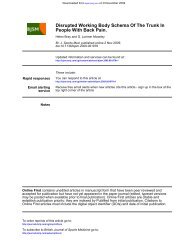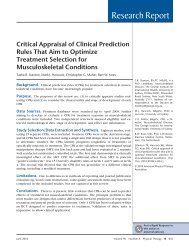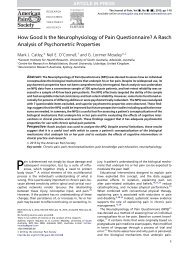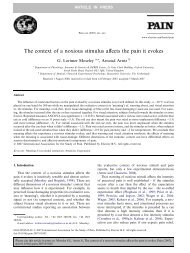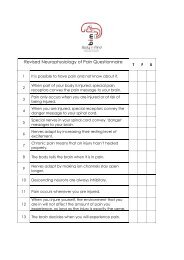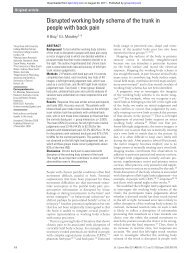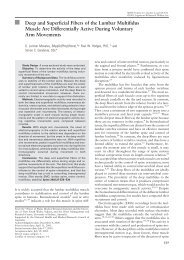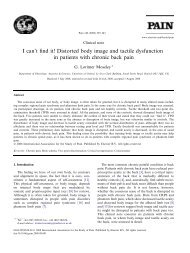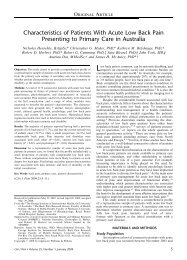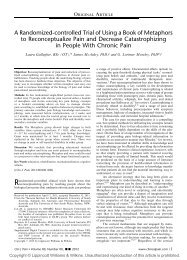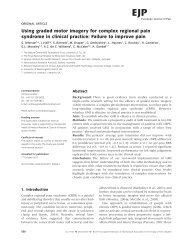The effect of motor control exercise versus placebo in patients with ...
The effect of motor control exercise versus placebo in patients with ...
The effect of motor control exercise versus placebo in patients with ...
Create successful ePaper yourself
Turn your PDF publications into a flip-book with our unique Google optimized e-Paper software.
BMC Musculoskeletal Disorders 2005, 6:54<br />
http://www.biomedcentral.com/1471-2474/6/54<br />
recognition <strong>of</strong> the major health and economic burden<br />
that these diseases place on the Australian community [3].<br />
Amongst this group <strong>of</strong> diseases back pa<strong>in</strong> is both the most<br />
prevalent and most costly s<strong>in</strong>gle disease [4]. <strong>The</strong> 2001<br />
National Health Survey revealed that chronic back pa<strong>in</strong> is<br />
the most prevalent illness from the seven National Health<br />
Priority Areas [5].<br />
<strong>The</strong> severity <strong>of</strong> chronic pa<strong>in</strong> can be described <strong>with</strong> four<br />
hierarchical grades, Grades I–IV, that consider the pa<strong>in</strong><br />
<strong>in</strong>tensity and the degree <strong>of</strong> disability associated <strong>with</strong> the<br />
pa<strong>in</strong> [6]. An Australian population-based survey, noted<br />
that 22% <strong>of</strong> respondents reported chronic pa<strong>in</strong> <strong>with</strong> 39%<br />
<strong>of</strong> respondents classed as Grade I (least severe), 35% as<br />
Grade II, 14% as Grade III and 13% as Grade IV (most<br />
severe) [7]. <strong>The</strong> most common cause <strong>of</strong> chronic pa<strong>in</strong> was<br />
low back pa<strong>in</strong> (45% <strong>of</strong> cases).<br />
Effectiveness <strong>of</strong> treatments for chronic low back pa<strong>in</strong><br />
While there are a myriad <strong>of</strong> treatment options for chronic<br />
low back pa<strong>in</strong>, there is only one cl<strong>in</strong>ical practice guidel<strong>in</strong>e<br />
for chronic non-specific low back pa<strong>in</strong>: <strong>The</strong> European<br />
Guidel<strong>in</strong>e[8]. This guidel<strong>in</strong>e and the relevant Cochrane<br />
reviews [9] provide the most reliable sources <strong>of</strong> evidence<br />
on treatment for this condition. Unfortunately the<br />
Cochrane reviews provide fairly bleak read<strong>in</strong>g for both cl<strong>in</strong>icians<br />
and <strong>patients</strong>. Most <strong>of</strong> the reviews (7/13) concluded<br />
that the treatment under review was <strong>of</strong> unknown<br />
value. Five <strong>of</strong> the thirteen reviews concluded that there<br />
was some evidence for the treatment under review however<br />
significant limitations for each treatment were noted.<br />
<strong>The</strong>se limitations <strong>in</strong>cluded: no long term <strong>effect</strong> (e.g. back<br />
school); serious side <strong>effect</strong>s (e.g. muscle relaxants); small<br />
<strong>effect</strong> size (e.g. massage); treatment improves outcomes<br />
other than pa<strong>in</strong> (e.g. work condition<strong>in</strong>g) and no <strong>in</strong>formation<br />
available on patient or dose selection (e.g. behavioural<br />
treatment). <strong>The</strong> European Guidel<strong>in</strong>e produced<br />
similar conclusions [8]. In only one Cochrane review, the<br />
review <strong>of</strong> multidiscipl<strong>in</strong>ary rehabilitation/functional restoration,<br />
did the reviewers conclude that there was strong<br />
evidence for the therapy. However the reviewers also<br />
noted that these programs were only <strong>effect</strong>ive when they<br />
<strong>in</strong>cluded >100 hours <strong>of</strong> therapy. Because these programs<br />
are multidiscipl<strong>in</strong>ary they are typically provided <strong>in</strong> a tertiary<br />
sett<strong>in</strong>g and because <strong>of</strong> the amount <strong>of</strong> time <strong>in</strong>volved<br />
they are also very expensive. Accord<strong>in</strong>gly functional restoration<br />
is usually reserved for the most severe cases <strong>of</strong><br />
chronic low back pa<strong>in</strong>.<br />
<strong>The</strong> majority <strong>of</strong> <strong>patients</strong> <strong>with</strong> chronic low back pa<strong>in</strong> has<br />
less severe pa<strong>in</strong> (i.e. Grades I–III) and are typically managed<br />
<strong>in</strong> primary care. Not surpris<strong>in</strong>gly cl<strong>in</strong>icians f<strong>in</strong>d manag<strong>in</strong>g<br />
chronic low back pa<strong>in</strong> difficult <strong>with</strong> qualitative<br />
research report<strong>in</strong>g that therapists' <strong>in</strong>ability to identify<br />
<strong>effect</strong>ive treatment choices for their <strong>patients</strong> makes them<br />
state cl<strong>in</strong>icians perhaps feel 'helpless' 'disillusioned' and<br />
'pessimistic' [10]. Studies <strong>of</strong> <strong>patients</strong> reveal similar negative<br />
feel<strong>in</strong>gs and emotions [11].<br />
To address this major problem, we plan to beg<strong>in</strong> a coord<strong>in</strong>ated<br />
program <strong>of</strong> research <strong>in</strong> which treatments that seem<br />
most promis<strong>in</strong>g are rigorously evaluated <strong>in</strong> randomised<br />
<strong>control</strong>led trials. We def<strong>in</strong>e 'most promis<strong>in</strong>g treatments'<br />
as those that (i) appear to have cl<strong>in</strong>ically important <strong>effect</strong>s<br />
that are ma<strong>in</strong>ta<strong>in</strong>ed <strong>in</strong> the long term, (ii) are readily available<br />
and <strong>of</strong> modest cost and (iii) there is biological plausibility<br />
for the <strong>effect</strong>. Exercise therapy is our first candidate<br />
for evaluation <strong>in</strong> this program <strong>of</strong> research because it satisfies<br />
each <strong>of</strong> these three criteria, however at present trials<br />
have reported conflict<strong>in</strong>g results.<br />
While some trials <strong>of</strong> <strong>exercise</strong> therapy have reported large,<br />
durable and cl<strong>in</strong>ically important <strong>effect</strong>s <strong>of</strong> treatment<br />
[12,13] others have not [14]. <strong>The</strong> uncerta<strong>in</strong>ty is reflected<br />
<strong>in</strong> the conclusion <strong>of</strong> the Cochrane review <strong>of</strong> <strong>exercise</strong> therapy:<br />
'...there is conflict<strong>in</strong>g evidence on the <strong>effect</strong>iveness <strong>of</strong><br />
<strong>exercise</strong> therapy...' [15]<br />
Many factors are likely to have contributed to the <strong>in</strong>consistent<br />
results across trials. Importantly, <strong>in</strong>terpretation <strong>of</strong><br />
the results <strong>of</strong> <strong>exercise</strong> trials is difficult because most trials<br />
have been pragmatic trials, compar<strong>in</strong>g two active treatments<br />
delivered <strong>in</strong> rout<strong>in</strong>e practice (e.g. <strong>exercise</strong> vs. usual<br />
medical care [12]; <strong>exercise</strong> vs. physiotherapy [16]) <strong>The</strong>se<br />
comparisons cannot provide a clear estimate <strong>of</strong> the <strong>effect</strong>s<br />
<strong>of</strong> <strong>exercise</strong> treatment because most <strong>of</strong> the comparison<br />
treatments are also <strong>of</strong> unknown efficacy. Secondly, there<br />
has been <strong>in</strong>sufficient appreciation by researchers conduct<strong>in</strong>g<br />
trials and by reviewers summaris<strong>in</strong>g trials <strong>of</strong> the wide<br />
variety <strong>of</strong> forms <strong>exercise</strong> can take and also trials do not<br />
<strong>control</strong> the quality <strong>of</strong> <strong>exercise</strong> <strong>in</strong>tervention. While <strong>exercise</strong><br />
is typically regarded as a s<strong>in</strong>gle class <strong>of</strong> treatment we<br />
believe that this level <strong>of</strong> conception is <strong>in</strong>appropriate and<br />
analogous to not dist<strong>in</strong>guish<strong>in</strong>g between different classes<br />
and doses <strong>of</strong> drugs when prescrib<strong>in</strong>g medication. <strong>The</strong><br />
types <strong>of</strong> <strong>exercise</strong> programs for chronic low back pa<strong>in</strong> vary<br />
widely from land-based <strong>exercise</strong> <strong>versus</strong> <strong>exercise</strong> <strong>in</strong> water to<br />
isolated trunk <strong>exercise</strong> <strong>versus</strong> a walk<strong>in</strong>g program and it is<br />
unlikely that all programs are equally <strong>effect</strong>ive for all<br />
<strong>patients</strong>. Lastly, methodological quality varies greatly<br />
across previous <strong>exercise</strong> trials, for example <strong>in</strong> the<br />
Cochrane review [15] the least sound trial attended to<br />
none <strong>of</strong> the n<strong>in</strong>e methodological criteria while the best<br />
attended to seven <strong>of</strong> the n<strong>in</strong>e. Because methodological<br />
quality has been shown to affect the results <strong>of</strong> trials <strong>in</strong><br />
other areas <strong>of</strong> health care [17] it is likely that a lack <strong>of</strong> rigor<br />
has contributed to the <strong>in</strong>consistent results.<br />
It is not sensible to talk about evaluat<strong>in</strong>g the efficacy <strong>of</strong><br />
<strong>exercise</strong> <strong>with</strong>out specify<strong>in</strong>g the type <strong>of</strong> <strong>exercise</strong>. We have<br />
Page 2 <strong>of</strong> 8<br />
(page number not for citation purposes)



